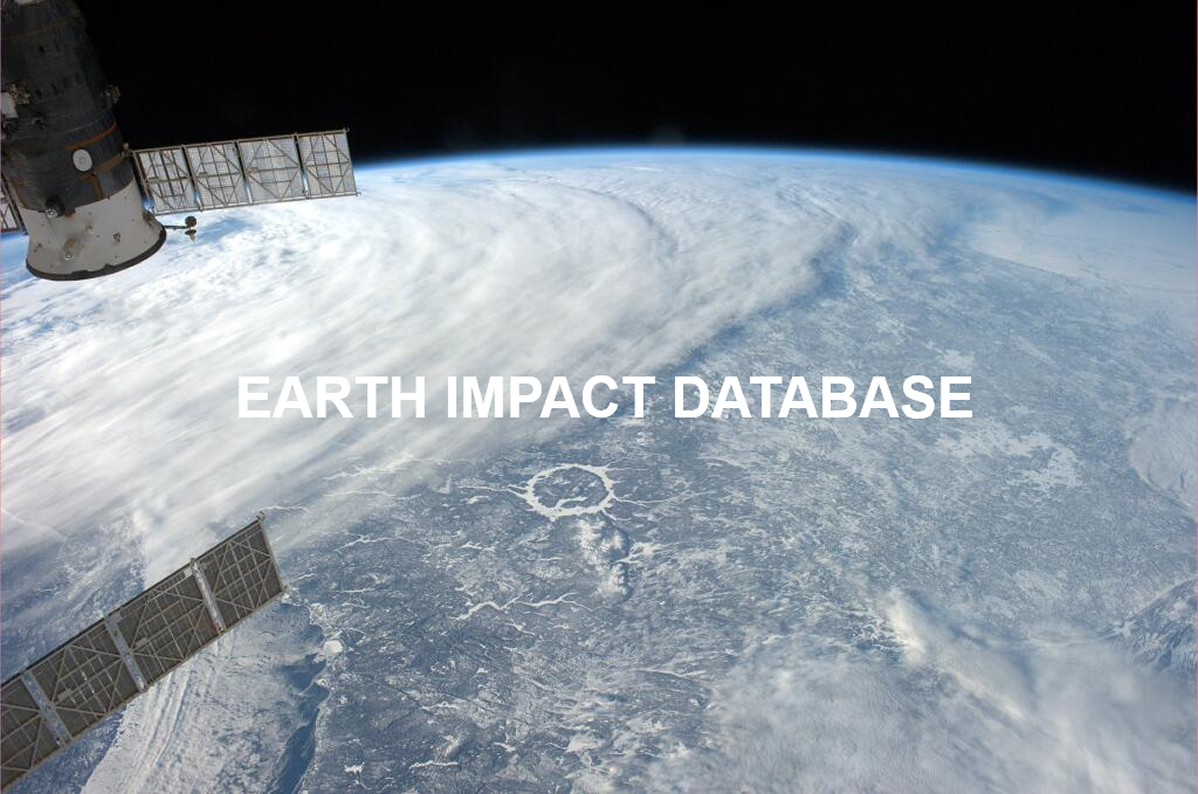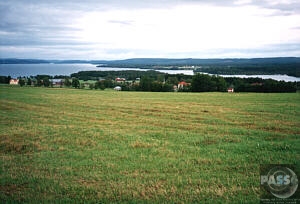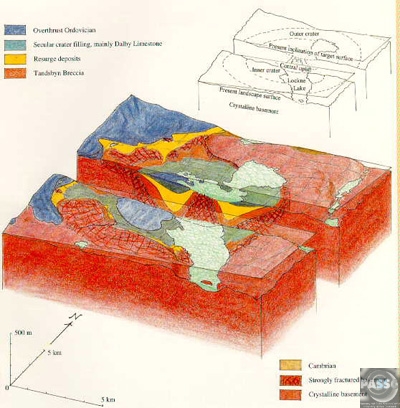Lockne
| Crater Name | Location | Latitude | Longitude | Diameter (km) | Age (Ma) | Exposed | Drilled | Target Rock** | Bolide Type*** |
|---|---|---|---|---|---|---|---|---|---|
| Lockne | Sweden | N 63° 0' | E 14° 49' | 7.5 | ~ 458 | Y | Y | M | - |
NOTE: The diameter of Lockne is here quoted as 7.5 km, the diameter of the structure within the crystalline basement. The wider 13.5 km diameter structure in the overlying supracrustal sedimentary rocks is believed by some researchers to also have formed by primary excavation flow, and thus could be interpreted as the diameter (Ormo, pers comm).
1. Photograph - view towards south
2. Geological block diagram
References |
Abels A., Plado J., Pesonen L.J., Lehtinen M., The impact cratering record of Fennoscandia - A close look at the database, 2002. |
Agarwal, A., Reznik, B., Kontny, A., Heissler, S., Schilling, F., Lingunite-a high-pressure plagioclase polymorph at mineral interfaces om dp;eritic rock of the Lockne impact structure (Sweden). Scientific Reports, 6:25991. 2016. |
Allen, J.R.L. (1984) Sedimentary Structures, their Character and Physical Basis. Developments in Sedimentology. 30. Elsevier, Amsterdam. |
Alwmark, C., Alwmark-Holm, S., Ormo, J., and Sturkell, E. Shocked quartz grains from the Malingen Structure, Sweden; evidence for a twin crater of the Lockne impact structure. Meteoritics & Planetary Science, vol.49, pp.1076. 2014. |
Alwmark, C., Schmitz, B., Extraterrestrial chromite in the resurge deposits of the early Late Ordovician Lockne crater, central Sweden. Earth and Planetary Science Letters, 253, P. 291 - 303. 2007. |
Aspler, L.B. and Donaldson, J.A. (1986) Penecontem-poraneous sandstone dykes, Nonacho Basin (early Proterozoic, Northwest Territories): horizontal injection in vertical, tabular fissures. Can. J. Earth Sci., 23, 827–838. |
Claesson, S. and Lundqvist, T. 1995. Origins and ages of Proterozoic granitoids in the Bothnian Basin, central Sweden; isotopic and geochemical constraints. Lithos, 36: 115–140. |
Clayton, R.N. and Steiner, A. 1975. Oxygen isotope studies of the geothermal system at Wairakei, New Zealand. Geochimica et Cosmochimica Acta, 39: 1179–1186. |
Dalwigk, I.,von., Ormo, J., Formation of resurge gullies at impacts at sea: The Lockne Crater, Sweden, Meteoritics & Planetary Science 36, abs. 3. 2001. |
Diller, J.S. (1890) Sandstone dikes. Bull. Geol. Soc. Am., 1, 411–442. |
Dzulynski, St. and Radomski, A. (1957) Zagadnienie zyl klastycznych w osadach fliszowych na tle sedymentacji fliszu karpackiego (Clastic dikes in the Carpathian Flysch). Rocznik Polskiego Towarzystwa Geologicznego, 26, 225–264. |
Ekelund, A., Sturkell, E. F. F., Shattercones from the Lockne impact-structure in central Sweden (abstract). Second International Conference. Impact Cratering and Evolution of Planet Earth. The Identification and Characterization of Impacts. 1994. |
Forsberg, P., Sturkell, E.F.F., Broman, C. and Torssander,P., Stable isotopes and fluid inclusions in cavity grown minerals from the Lockne impact breccia, Jämtland, Sweden (abstract). GFF, v. 118, pp. A98-A99. 1996. |
Frödin, G. (1920) Om de s.k. prekambriska kvartsit-sparagmitformationerna i Sveriges sydliga fjälltrakter. Sveriges Geologiska Undersökning. C, 299, 1–66. |
Giletti, B.J. 1986. Diffusion effects on oxygen isotope temperatures of slowly cooled igneous and metamorphic rocks. Earth and Planetary Science Letters, 77: 218–228. |
Grahn, Y., Chitinozoan Biostratigraphy of the Early Caradocian Lockne Impact Structure, Jamtland, Sweden, Meteoritics; vol. 32, p. 745-51. 1997. |
Grahn, Y., Nolvak, J and Paris,F., Precise chitinozoan dating of Ordovician impact events in Baltoscandia, Journal of Micropalaeontology, v.15, p.21-35. 1996. |
Grahn, Y., Nolvak, J., Chitinozoan dating of Ordovician impact events in Sweden and Estonia. A preliminary note. Geologiska Föreningens I Stockholm Förhandlingar, v. 115, pp. 263-264. 1993. |
Henkel, H., Pesonen, L. J., Impact craters and craterform structures in Fennoscandia. Tectonophysics, v. 216, pp. 31-40. 1992. |
Hesse, R. and Reading, H.G. (1978) Subaqueous clastic fissure eruptions and other examples of sedimentary transposition in the lacustrine Horton Bluff Formation (Mississippian) Nova Scotia, Canada. In: Modern and Ancient Lake Sediments (Ed. by A. Matter and M. E. Tucker), Spec. Publ. Int. Ass. Sedim., 2, 241–257. |
Högdahl, K. 2000. 1.86-1.85 Ga intrusive ages of K-feldspar megacryst-bearing granites in the type area of the Revsund granites in Jämtland County, central Sweden. GFF, 122: 359–366. |
Högdahl, K. and Sjöström, H. 2001. Evidence for 1.82 Ga transpressive shearing in a 1.85 Ga granitoid in central Sweden: Implications for the regional evolution. Precambrian Research, 105: 37–56. |
Jaffrés, J.B.D., Shields, G.A. and Wallman, K. 2007. The oxygen isotope evolution of seawater: A critical review of a long-standing controversy and improved geological water cycle model for the past 3.4 billion years. Earth Science Reviews, 83: 83–122. |
Jenkins, O.P. (1925) Mechanics of Clastic Dike Intrusion. Engineering and Mining Journal-Press, 120, 12. |
Karis, L. and Strömberg, A.G.B. 1998. Beskrivning till berggrundskartan över Jämtlands län. Del 2: Fjälldelen (in Swedish with an English summary). Swedish Geological Survey Ca, 53(2) 363 pp |
Lambert, P. (1981) Breccia dikes: Geological constraints on the formation of complex craters. In Multi-Ring Basins Proceedings of Lunar and Planetary Science Volume 12, Part A (Ed. by P. H. Schultz and R. B. Merrill), Geochimica et Cosmochimica ACTA, Supplement, 15, 59–78. |
Larsson, K. (1973) The lower Viruan in the autochthonous Ordovician sequence of Jämtland. Sveriges Geologiska Undersökning, C, 683, 1–82. |
Lindstrom, M., Shuvalov, V. , Ivanov, B., Lockne crater as a result of marine-target oblique impact. Planetary and Space Science, Vol. 53, P. 803 - 815. 2005. |
Lindström, M., Sturkell, E.F.F., Ormö, J. and Törnberg,R., The Lockne marine impact in the Ordovician of central Sweden (abstract). Meteoritics & Planetary Science, v. 31, pp. A80-A81. 1996. |
Lindström, M., Ormö, J., Sturkell, E.F.F. and Törnberg,R., Geological information from Ordovician marine impact craters (abstract). GFF, v. 118, pp. A99-A100. 1996. |
Lindström, M., Sturkell, E.F.F., Törnberg, R. and Ormö,J., The marine impact crater at Lockne, central Sweden. GFF, v. 118, pp. 193-206. 1996. |
Lindstrom M., Six Ordovician Craters, 1995. |
Lindström, M., Presentation of Lockne, our host impact structure (abstract). Second International Conference. Impact Cratering and Evolution of Planet Earth. The Identification and Characterization of Impacts. 1994. |
Lindström, M., Flodén, T., Grahn, Y. and Kathol, B. (1994) Post-impact deposits in Tvären, a marine Middle Ordovician crater south of Stockholm, Sweden. Geol. Mog., 131, 91–103. |
Lindstrom M., Sturkell E.F.F., Geology of the Early Palaeozoic Lockne impact structure, central Sweden, 1992. |
Lindström, M., Ekvall, J, Hagenfeldt, S E., Sawe, B and Sturkell,E F.F., A well-preserved Cambrian impact exposed in Central Sweden. Geolgische Rundschau, v. 80/1, pp. 201-204. 1991. |
Lindström, M., Simon, S, Paul, B and Kessler,K., The Ordovician and its mass movements in the Lockne Area near the Caledonian margin, central Sweden. Geologica et Palaeontologica, v. 17, pp. 17-27. 1983. |
Lupher, R.L. (1944) Clastic dykes of the Columbia Basin region, Washington and Idaho. Geol. Soc. Am. Bull., 55, 1431–1462. |
Macaulay, C.I., Fallick, A.E., Haszeldine, R.S. and Graham, C.M. 2000. Methods of laser-based stable isotope measurements applied to diagenetic cements and hydrocarbon reservoir quality. Clay Minerals, 35: 313–322. |
Matsuhisa, Y., Goldsmith, J.R. and Clayton, R.N. 1979. Oxygen isotope fractionation in the system quartz-albite-anorthite-water. Geochimica et Cosmochimica Acta, 43: 1131–1140. |
Melosh, H.J. (1989) Impact Cratering. A Geologic Process. Oxford University Press, New York |
O'Neil, J.R. and Chappell, B.W. 1977. Oxygen and hydrogen isotope relations in the Berridale batholith. Journal of the Geological Society, 133: 559–571. |
O'Neil, J.R., Clayton, R.N. and Mayeda, T.K. 1969. Oxygen isotope fractionation in divalent metal carbonates. The Journal of Chemical Physics, 51: 5547–5558. |
Ormö, J., Sturkell, E. & Lepinette, A., 2010: Geological and numerical evidence for a crater bound sedimentary impact breccia lining the basement crater at the Lockne impact structure. 41st Lunar and Planetary Science Conference. Ground truth galore: Terrestrial impact craters, Session 203:1420 |
Ormo, J., Lindstrom, M., The Influence of Deep Shelf Sea on the Excavation and Modification of the Marine-Target Crater, the Lockne Crater, Central Sweden, Lunar and Planetary Science XXXV. 2004. |
Ormo, J., Next step in marine impact studies: combining geological data with numerical simulations for applications in planetary research, Workshop on Impact Cratering. 2003. |
Ormo, J., Shuvalov, V. V., Lindstrom,M., Numerical modeling for target water depth estimation of marine-target impact craters, Journal of Geophysical Research, v.107, No.E12. 2002. |
Ormo, J., Miyamoto, H., Computer modelling of the water resurge at a marine impact: the Lockne crater, Sweden, Deep Sea Research II, v.49, p.983-994. 2002. |
Ormo, J., Lindstrom, M., Sturkell, E.F.F., Tornberg, R., von Dalwigk,I., Lockne. A well-displayed marine-target in the heart of Scandinavia, Bolide Impacts on Wet Targets, Geological Society of America Field Forum Abstracts. 2001. |
Ormo, J., Lindstrom, M., When a cosmic impact strikes the sea bed, Geol. Mag. V.137(1), p.67-80. 2000. |
Ormo, J., Lindstrom, M., When a cosmic impact strikes the sea bed, Geol. Mag. V.137(1), p.67-80. 2000. |
Ormo, J., Lindstrom, M., Sturkell, E. and Tornberg,R., The Middle Ordovician Lockne crater as a small-scale model for impacts at sea (abstract). Large Meteorite Impacts and Planetary Evolution,. 1997. |
Ormö, J., Sturkell, E.F.F. and Törnberg,R., Magnetic model of the Lockne impact crater, central Sweden (abstract). GFF, v. 118, pp. A100-A102. 1996. |
Peterson, G.L. (1968) Flow structures in sandstone dikes. Sed. Geol., 2, 177–190. |
Potter, P.E. and Pettijohon, F.J. (1977) Paleocurrents and Basin Analysis. Springer-Verlag, Berlin . |
Roedder, E. 1984. Fluid inclusions. Mineralogical Society of America. Reviews in Mineralogy, 12 644 pp |
Savin, S.M. and Epstein, S. 1970. The oxygen and hydrogen isotope geochemistry of clay minerals. Geochimica et Cosmochimica Acta, 34: 25–42. |
Sharp, Z.D. 1990. A laser-based microanalytical method for the in-situ determination of oxygen isotope ratios in silicates and oxides. Geochimica et Cosmochimica Acta, 54: 1353–1357. |
Simon, S. (1987a) Stratigraphie, petrographie und entstehungsbedingungen von grobklastika in der autochthonen, Ordovizischen schichtenfolge Jämtlands (Schweden). Sveriges Geologiska Undersoöking. C, 815, 1–156. |
Simon, S. (1987b) Caledonian deformation of basement in the Lockne area, Jämtland, central Sweden. Geologiska Föreningens i Stockholm Förhandlingar, 106, 269–273. |
Smyers, N.B. and Peterson, G.L. (1971) Sandstone dikes and sills in the Moreno Shale, Panoche Hills, California. Geol. Soc. Am. Bull., 82, 3201–3208. |
| Snäll, S. 1988. Mineralogy and maturity of the alum shales of south-central Jämtland, Sweden. Swedish Geological Survey, C818: 1–46. |
Strurkell, E., Ormo, J., Nolvak, J., Wallin,A., Distant ejecta from the Lockne marine-target impact crater, Sweden, Meteorit. Planet. Sci. 35 (2000) 929-936. 2000. |
Sturkell, E., Ormo, J., Nolvak, J. and Wallin,A., Distant ejecta from the Lockne marine-target impact crater, Sweden, Meteoritics & Planetary Science Vol. 35, No. 5, pp. 929-936. 2000. |
Sturkell, E., Ormo, J., Nolvak, J., Wallin,A., Distant ejecta from the Lockne marine-target impact crater, Sweden, Meteoritics and Planetary Science, v.35, No.5, p.929-936. 2000. |
Sturkell, E. F. F., The origin of the marine Lockne impact structure, Jämtland. Ph.D. thesis Ph.D. Thesis, Stockholm University, Stockholm,. 1998. |
Sturkell E.F.F.,Ekelund A. , Tomberg R., Gravity modelling of Lockne, a marine impact structure in Jamtland, central Sweden, 1998. |
Sturkell, E. F. F., Ormö, J., Magnetometry of the marine, Ordovician Lockne impact structure, Jämtland, Sweden. Journal of Applied Geophysics, v. 38, pp. 195-207. 1998. |
Sturkell, E. F. F., Resurge morphology of the marine Lockne impact crater, Jamtland, central Sweden, Geological Magazine, v 135, n 1, p 121-127. 1998. |
Sturkell, E. F. F., Impact-related Ir anomaly in the Middle Ordovician Lockne impact structure, Jamtland, Sweden, GFF, v 120, p 333-336. 1998. |
Sturkell E.F.F. et Al, Impact-related hydrothermal activity in the Lockne impact structure, Jamtland, Sweden, 1998. |
Sturkell, E. F. F., Lindström, M., Mass balance of the Lockne impact structure, central Sweden (abstract). GFF, v. 118, pp. A102-A103. 1996. |
Sturkell, E. F. F., Lindström, M., Interrelation between the Lockne impact structure and regional left-lateral strike-slips (abstract). Second International Conference. Impact Cratering and Evolution of Planet Earth. The Identification and Characterization of Impacts. 1994. |
Sturkell, E. F. F., Tremadocian Ceratopyge limestone identified by means of conodonts, in Jämtland, Sweden. Geologiska Föreningens i Stockholm Förhandlingar (GFF), v. 113, pp. 185-188. 1991. |
Sturkell, E. R. R., Ormö, J., Impact-related clastic injections in the marine Ordovician Lockne impact structure, Central Sweden. Sedimentology, v. 44, pp. 793-804. 1997. |
Sturkell E.F.F., Kathol B., Jamtlands Sedimentara Berggrund, 1990. |
Sundblad, K., Lead isotopic composition of galena associated with the Early Palaeozoic meteorite impact structures at Lockne (Sweden) and Kardla (Estonia) (abstract). European Science Foundation, Second International Conference. Impact Cratering and Evolution of Planet Earth. The Identification and Characterization of Impacts.,. 1994. |
Talbot, C.J. and von Brunn, V. (1989) Melanges, intrusive and extrusive sediments, and hydraulic arcs. Geology, 17, 446–448. |
Taylor, H.P. Jr. 1980. The effects of assimilation of country rocks by magmas on 18O/16O and 87Sr/86 Sr systematics in igneous rocks. Earth and Planetary Science Letters, 47: 243–254. |
Therriault, A. M., Lindström, M., Planar deformation features in quartz grains from the resurge deposit of the Lockne structure, Sweden. Meteoritics, v. 30, pp. 700-703. 1995. |
Therriault, A. M., Lindström, M., Planar deformation features in quartz grains from resurge deposit of the Lockne structure, Sweden (abstract). Lunar and Planetary Science XXV, pp. 1385-1386. 1994. |
Therriault, A. M., Lindström, M., Planar deformation features in quartz grains from resurge deposit of the Lockne structure, Sweden (abstract). Second International Conference. Impact Cratering and Evolution of Planet Earth. The Identification and Characterization of Impacts. 1994. |
Thorslund, P. (1940) On the Chasmops series of Jemtland and Södermanland (Tvären). Sveriges Geologiska Undersökning. C, 494, 1–191. |
Thorslund, P. and Asklund, B. (1935) Stratigrafiska och tektoniska studier inom Föllingeomrädet i Jämtland. Sveriges Geologiska Undersökning. C. 388, 1–61. |
Törnberg, R., Impact-related resurge sedimentology as exemplified by the Lockne, Tvären and Kärdla structures (abstract). GFF, v. 118, p. A102. 1996. |
von Dalwigk, I., Ormo, J., Formation of resurge gullies at impacts at sea: The Lockne crater, Sweden, Meteoritics & Planetary Science, March 2001, v.36 (is. 3), pp. 359-369. 2001. |
von Dalwigk, I., Ormo, J., Formation of resurge gullies at impacts at sea: The Lockne crater, Sweden, Meteoritics and Planetary Science 36, 359-369. 2001. |
von Dalwigk, I., Ormo, J., The formation of resurge gullies during impacts at sea: the Lockne crater, Sweden, Bolide Impacts on Wet Targets, Geological Society of America Field Forum Abstracts. 2001. |
von Dalwigk, I., Ormo, J., Formation of resurge gullies at impacts at sea: the Lockne crater, Sweden, abstract, ESF IMPACT Workshop on Oceanic Impacts, Alfred Wegener Institute Bremerhaven, pp. 23-26. 1999. |
Wallin, B. 1982. Sedimentology of the Lower Cambrian sequence at Vassbo, Sweden. Stockholm Contributions in Geology, 39(1): 1–111. |
Wallmann, K. 2001. The geological water cycle and the evolution of marine d18O values. Geochimica et Cosmochimica Acta, 6: 2469–2485. |
Wickman, F. E., Possible impact structures in Sweden. A. Boden and K.G. Eriksson, eds., in Deep Drilling in Crystalline Bedrock, Springer-Verlag, Berlin, p. 298-327. 1988. |
Wilshire, H.G., Howard, K.A. and Offield, T.W. (1971) Impact Breccias in Carbonate Rocks, Sierra Maderas, Texas. Geol. Soc. Am. Bull., 82, 1009–1018. |
Wilson, M.R., Hamilton, P.J., Fallick, A.E., Aftalion, M. and Michard, A. 1985. Granites and early crustal evolution in Sweden: Evidence from Sm-Nd, U-Pb, and O isotope systematics. Earth and Planetary Science Letters, 72: 376–388. |
Young, G.M. (1968) Sedimentary structures in Huronian rocks of Ontario. Palaeogeo., Palaeoclim., Palaeoecol., 4, 125–153. |
| * pre-1977 K-Ar, Ar-Ar and Rb-Sr ages recalculated using the decay constants of Steiger and Jager (1977) Ages in millions of years (Ma) before present. ** Abbreviations: C - Crystalline Target; C-Ms - Metasedimentary Target; M - Mixed Target (i.e.sedimentary strata overlying crystalline basement); S - sedimentary target (i.e. no crystalline rocks affected by the impact event). From Osinski. G. R., Spray J. G., and Grieve R. A. F. 2007. Impact melting in sedimentary target rocks: A synthesis. In The Sedimentary Record of Meteorite Impacts, Geological Society of America Special Paper. Editors: Evans K. Horton W., King D., Morrow J., and Warme J. Geological Society of America: Boulder, in press. ***From Koeberl,C. Identification of meteoritic components in impactites. 1998, Koeberl, C. The Geochemistry and Cosmochemistry of Impacts. 2007 and PASSC Files. (IAB, IIIAB, IIIB, IIID - Iron Meteorite) |


